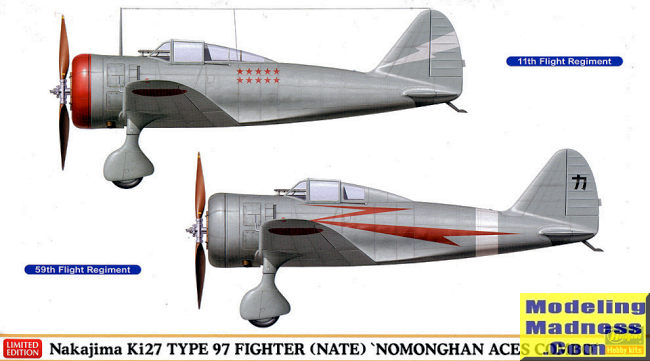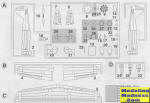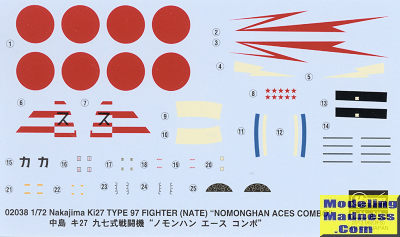
Hasegawa 1/72 Ki-27 'Nate' (Nomonghan Aces)
| KIT #: | 02038 |
| PRICE: | 2600 yen SRP |
| DECALS: | Three options |
| REVIEWER: | Scott Van Aken |
| NOTES: | Two complete kits. |

| HISTORY |
The Ki-27 was the IJAAF's main fighter prior to the start of World War II. It was also one of the first monoplane fighters in Japanese service. In the 1939 Battle of Kalhin Gol against USSR in Mongolia, Ki-27 faced I-15 biplanes and I-16 monoplanes, and dominated them with its maneuverability, downing a total of 1,252 enemy aircraft. The Ki-27's high turn performance was a result of the Army's focus almost exclusively on maneuverability, a decision which came back to haunt them later as it handicapped the development of more heavily armed and faster fighters. The Ki-27 served in the very early months of World War II in the Pacific, operating out of China, southeast Asia and the Philippines. Many of the 'Zeros' shot down by the Flying Tigers were Ki-27s. After it was replaced by the Ki-43, Ki-27 continuing to serve as a trainer, was used in 'back water' areas and for home defense. It was also exported for use with Manchukuo and Thai armed forces, seeing combat with both. In Thai service, the Ki-27 reportedly damaged a P-51 Mustang and shot down one P-38 Lightning. Near the end of World War II, a few Ki-27 were equipped with up to 500 kg (1,100 lb) of explosives for Kamikaze duty.
In spite of its excellent turning performance, in combat Ki-27 suffered from lack of armor protection for the pilot and absence of self-sealing or fire suppression in the fuel tanks. In addition, the airframe could not handle the stress of high speeds and Soviet pilots routinely escaped Ki-27 attacks in a dive. The armament of two rifle-caliber machine guns was weak. Many of these planes were shot down by the P-40s of the AVG. The main difference between the Ki-27a and Ki-27b was the latter's addition of bomb racks and the provision for under wing fuel tanks.
| THE KIT |
 Hasegawa's
offering of the Ki-27 in this scale is not a new kit by any means. It is one of
several kits purchased from Mania when they went out of business in the 1970s.
It has raised panel lines and considering how often this one has been re-issued,
the sprues are in quite good shape with minimal flash and only on a few parts.
There are some ejector pin marks I'd rather not have but all standard stuff for
the time. Hasegawa has been producing a lot of Combo kits in the last few years.
Most of these are older molds than have frequently been surpassed by newer
kits, but none are so horrible as to not be worth building.
Hasegawa's
offering of the Ki-27 in this scale is not a new kit by any means. It is one of
several kits purchased from Mania when they went out of business in the 1970s.
It has raised panel lines and considering how often this one has been re-issued,
the sprues are in quite good shape with minimal flash and only on a few parts.
There are some ejector pin marks I'd rather not have but all standard stuff for
the time. Hasegawa has been producing a lot of Combo kits in the last few years.
Most of these are older molds than have frequently been surpassed by newer
kits, but none are so horrible as to not be worth building.
The cockpit is rather basic with a floor, control stick and seat back shape. This latter piece seems far too tall and I think one would be well off to reduce it in height. Unlike the earlier boxings, this one provides an instrument panel decal, but be advised that if you put the panel in its designated location, you won't see it. The cockpit is supposed to be filled with pilot so any detailing will have to come from somewhere else. A single piece engine/oil cooler assembly is provided and it fits into a single-piece cowling. Interestingly, the Hucks starter lug is a separate piece and fits on the prop.
A one piece lower wing and two upper halves are the norm for this and it fits under the completed fuselage. Now for the options. You can have standard landing gear, the lower fairing removed, or later gear with balloon tires. However, you need to save the latter two for an aftermarket sheet as all the options for this boxing are standard gear. Fuel tanks are provided and if you don't want to use them, you have to fill the placement holes. One also has an early or later rear canopy and one of the options does use the longer early rear section. There is a telescopic gun sight, a gun camera (don't want to use it; fill the hole) and a pitot tube to round things off.
 As kits go,
this one is pretty simple. There are only five construction steps and those take
up 1/4 of the sheet. Most of the rest deals with the three markings options. Two
are shown on the box art. All the aircraft are in overall green-grey though
Hasegawa wants you to paint them light grey. First one is piloted by W.O.
Hiromichi Shinohara, the next with the big fuselage flash by Sgt. Major Isamu
Kashiida, and the third one, which is from the 24th Flight Regiment and has the
striped fin/rudder markings was flown by Sgt. Gorou Nishihara. All are from the
June-August 1939 time frame. The decal sheet is very nicely done and should
present no issues at all.
As kits go,
this one is pretty simple. There are only five construction steps and those take
up 1/4 of the sheet. Most of the rest deals with the three markings options. Two
are shown on the box art. All the aircraft are in overall green-grey though
Hasegawa wants you to paint them light grey. First one is piloted by W.O.
Hiromichi Shinohara, the next with the big fuselage flash by Sgt. Major Isamu
Kashiida, and the third one, which is from the 24th Flight Regiment and has the
striped fin/rudder markings was flown by Sgt. Gorou Nishihara. All are from the
June-August 1939 time frame. The decal sheet is very nicely done and should
present no issues at all.
| CONCLUSIONS |
I purchased this from evil-bay as I wanted to have some additional kits of this plane for future builds. The kit does build somewhat quickly, though it is not a toss-together one and you'll need to use some modeling skills, filler and sandpaper to get a nice result.
July 2017 Copyright ModelingMadness.com.
All rights reserved. If you would like your product reviewed fairly and fairly quickly, please
contact
the editor or see other details in the
Note to
Contributors.
Back to the Main Page
Back to the Review
Index Page
Back to the Previews Index Page